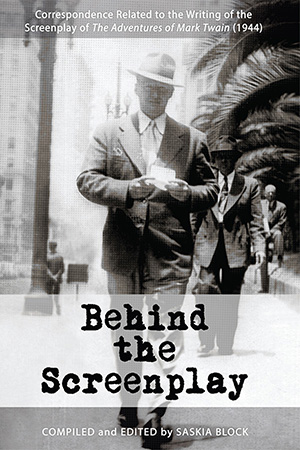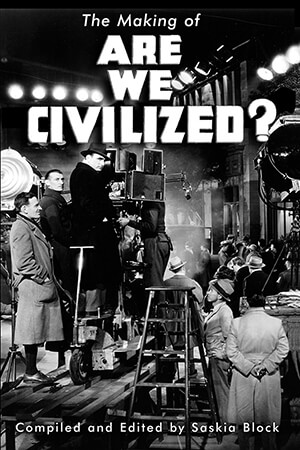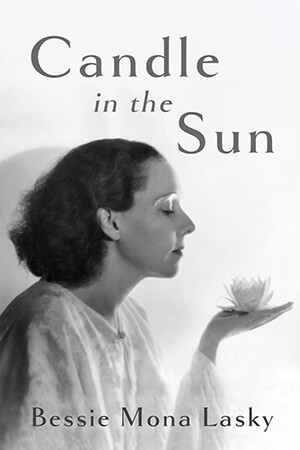Hollywood books
Behind the Screenplay
Correspondence Related to the Writing of the Screenplay of The Adventures of Mark Twain (1944)
Compiled and Edited by Saskia Block
This book is made up of letters that document what went on behind the scenes in writing the screenplay of the 1944 Warner Bros. film, The Adventures of Mark Twain. The main correspondents are New York playwright and author Harold M. Sherman, Mark Twain Estate attorney Charles T. Lark, the film’s producer Jesse L. Lasky, and Mark Twain’s daughter Clara Clemens Gabrilowitsch. In 1936 Sherman wrote a stage play titled “Mark Twain” and submitted it to the Mark Twain Estate, who granted him exclusive dramatic rights for a limited period. Gabrilowitsch generally approved of the play, and after meeting Sherman and his wife, Martha, discovered they shared a mutual interest in spirituality. A close friendship developed between the three. Sherman soon sold “Mark Twain” to Broadway producer, Harry Moses, but when Moses died suddenly the rights reverted to Sherman. By 1940, unable to find another Broadway producer, Sherman agreed to sell the play to Hollywood. Later that year, pioneer filmmaker Jesse Lasky, by then an independent interested mainly in making films about great Americans, chose Mark Twain for his next subject. In his deal with the Mark Twain Estate for the movie rights to Twain’s life story, Lasky was obliged to buy Sherman’s play. Lasky and Sherman then signed an option agreement hiring Sherman to write the preliminary treatment for shopping the proposed film around to major studios. The letters begin with this option agreement and go on to detail the unfolding relationships among the four main correspondents. They describe how Lasky dealt with the ambitious but inexperienced Sherman; how Sherman had to swallow his pride when Lasky replaced him with big-name Hollywood writers; how the Sherman-Gabrilowitsch friendship disintegrated as Clara’s dissatisfaction with the contracts and the final script led her to file suit against the trustees of her own estate; and how Lasky and his wife Bessie formed a personal relationship with Harold and Martha Sherman, while maintaining a professional distance.
292 pages. Print $11.99; Kindle $4.99.
The Making of
Are We Civilized?
Compiled and Edited by Saskia Block
Based on correspondence and images found in writer Harold Sherman's archive at the University of Central Arkansas, this book tells the story of the making and marketing of Are We Civilized?, an independently produced feature film from 1934, which portrayed the heroes and villains of world history and warned of the dangers of twentieth century dictatorships leading to further world wars. The central voice is that of Sherman, the film’s ambitious young writer on his first Hollywood assignment. Back in New York he had written the screenplay and suggested accompanying producers Ed Raschbaum and Sidney T. Pink west during filming, for any additional writing and to oversee the story in an advisory capacity. In the first half, Sherman’s daily letters to his wife Martha back in New York vividly describe 1930s Hollywood and his interactions with cast and crew, made up largely of individuals either on the way down from their silent-film glory days, such as director Edwin Carewe and star William Farnum, or on the way up to become Oscar winners, such as cinematographer Leon Shamroy. Optimism abounded as everyone involved in the movie—Sherman in particular—believed they were working on a milestone production that would take the nation by storm. The second half tells the story of how this obscure but curiously interesting “message film” fared in Depression-era America, when the majors dominated the industry.
Print: 236 pages, $11.95; Kindle $4.95
Candle in the Sun
By Bessie Mona Lasky
First published in 1957, this is the revised and footnoted autobiography of Bessie Lasky—wife of Hollywood founding father Jesse L. Lasky—a successful artist in her own right who wanted nothing more than to escape the glitter and glamor and live in her own simple world of poetry, art and music.
“We lived in separate worlds. But if I had forced her to live in mine, I would have lost her, and that would have been a tragedy for me.” —Jesse L. Lasky Sr., husband
“Her survival—from simple family background, convent education through the glittering towers of material illusions, the halls of Babylon on the Pacific—is a true passage through many mansions. This book holds a priceless message for all who have known the complex loneliness of a crowded world of material frustration. It points like the needle of a compass through the storms of the heart—toward peace of mind.” —Jesse L. Lasky Jr., son
“Bessie was not influenced by Hollywood. Instead, her heart ‘sang gaily of landscapes, still lifes, flower and water subjects.’ In her commitment to her paintbrush, Bessie found the fulfillment not provided by the world of private railroad cars, great houses, servants upstairs and down. . . .” —Betty Lasky, daughter
“When Jesse Lasky first saw Bessie across a room, he recognized her soul shining through her gentle face. Although they scarcely knew each other, within twenty-four hours Jesse had asked her to marry him. She instinctively understood the unique power and intelligence of the man and they were married almost immediately. Wife and husband led extraordinary solo lives, yet there was always an unbroken chord between them. This book reveals the unique essence of a spiritual woman who could express her tranquil soul in paint and poetry and yet play her part as wife and partner to a powerful and exceptionally creative man.” —Pat Silver-Lasky, daughter-in-law, author Hollywood Royalty
Print: 282 pages, $11.95; Kindle: $4.99



